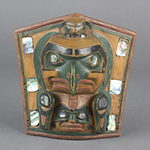
Attributed to John Taylor, William Shakespeare, ca. 1610, (Photo © National Portrait Gallery, London)
The National Portrait Gallery in London joins the growing list of museums making images of the works in their collections available for academic use without charge. But please note that these terms–at least for the largest images they provide–are more restrictive than those in some recent releases (such as the LACMA Image Library or NGA Images). While there is no fee for academic or non-commercial use of their images, you must still apply to the Gallery for permission to use them. Commercial use of their images still requires both a fee and permission.
You can read the full press release below:
NATIONAL PORTRAIT GALLERY PROVIDES FREE IMAGE DOWNLOADS FOR ACADEMIC AND NON-COMMERCIAL USE
The National Portrait Gallery now provides free downloads of a large range of images from its Collection for academic and non-commercial projects through a new web-site facility. Over 53,000 low-resolution images will now be available free of charge to non-commercial users through a standard ‘Creative Commons’ licence and over 87,000 high-resolution images will also be available free of charge for academic use through the Gallery’s own licences.
Since 1997 over 100,000 portraits from the Gallery’s Collection, including paintings, photographs, drawings, prints and sculptures have been digitised. The Gallery was among the first UK institutions to publish images online in a searchable database, and licensing of these images has raised some £5.5 million which has been re-invested in the Gallery’s work. Digitisation of the Collection is part of realising the Gallery’s mission ‘to promote through the medium of portraits the appreciation and understanding of the men and women who have made and are making British history and culture, and … to promote the appreciation and understanding of portraiture in all media’.
The new licensing process has been automated through the Gallery’s website but each transaction is individually agreed or denied by Gallery staff, to prevent potential abuse of the system and preserve the important revenue achieved from commercial image licensing. In order to help cover the cost and to highlight the value for beneficiaries of this new facility, users are invited to donate in support of the Gallery’s work. Not all of the portraits in the Collections have yet been scanned, and some are subject to copyright restrictions, so charges and restrictions will continue to apply to accessing some images, as well as to the commercial use of all images. Funds raised by image licensing activity will continue to contribute towards further digitisation.
National Portrait Gallery, St Martin’s Place, WC2H 0HE opening hours: Saturday-Wednesday: 10am – 6pm (Gallery closure commences at 5.50pm) Late Opening: Thursday, Fridays:10am – 9pm (Gallery closure commences at 8.50pm) Recorded information: 020 7312 2463 General information: 020 7306 0055 Website: www.npg.org.uk



![Caradosso, Pope Julius II [obverse] and View of Saint Peter's [reverse], 1506 (photo: Courtesy National Gallery of Art, Washington)](https://sites.udel.edu/vrc/files/2015/09/julius2-1zx0us2-150x150.jpg)



